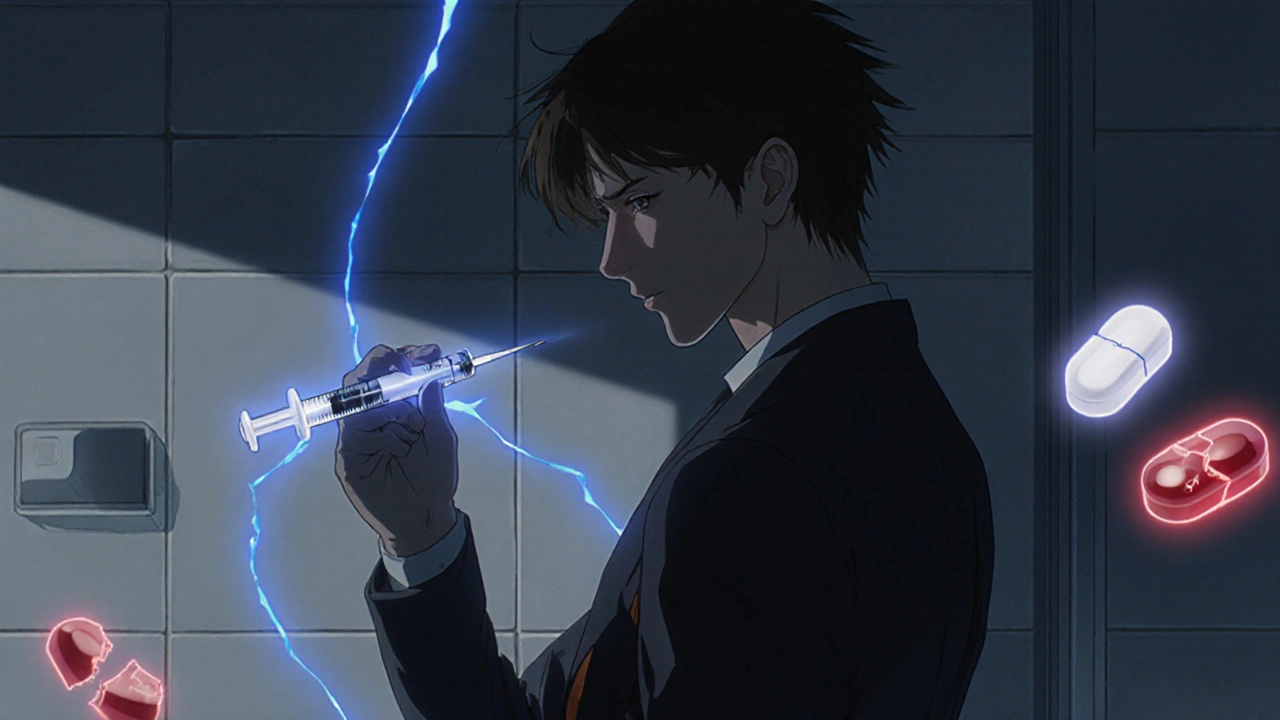ED Treatment Comparison Tool
When erectile dysfunction (ED) doesn’t respond to oral meds like Viagra or Cialis, doctors often turn to Alprostadil. It’s one of the few treatments that works directly on the penis, bypassing the need for systemic absorption. But Alprostadil isn’t the only option. There are other ways to get results-some easier, some more effective, some cheaper. So how does Alprostadil stack up against the alternatives? Let’s break it down with real-world data, user experiences, and what actually matters when you’re choosing a treatment.
What Is Alprostadil and How Does It Work?
Alprostadil is a synthetic version of prostaglandin E1, a naturally occurring compound in the body that relaxes smooth muscle and widens blood vessels. In ED, it increases blood flow to the penis, triggering an erection within 5 to 20 minutes. It’s not a pill. It’s delivered either as an injection into the side of the penis (brand name: Caverject) or as a tiny urethral suppository (brand name: MUSE).
Both forms are FDA-approved and have been used since the 1980s. Studies show about 60-80% of men achieve an erection firm enough for intercourse with Alprostadil injections. MUSE is less effective-around 40-50% success rate-but avoids needles. The effect lasts 30 to 60 minutes. Unlike oral drugs, Alprostadil doesn’t rely on sexual stimulation to work. You can use it on demand, anytime, without waiting for a pill to kick in.
How Alprostadil Compares to Oral Medications
Most men start with pills: sildenafil (Viagra), tadalafil (Cialis), or vardenafil (Levitra). These are PDE5 inhibitors. They work by boosting nitric oxide, which helps relax penile muscles. But they need sexual arousal to trigger the effect. They also take 30-60 minutes to start working and can be affected by food or alcohol.
Alprostadil wins in speed and reliability for men who don’t respond to pills. A 2023 study in the Journal of Sexual Medicine found that 72% of men who failed oral therapy responded to Alprostadil injections. That’s a huge jump. But pills have advantages too: they’re non-invasive, cheaper (especially generics), and don’t require special training to use.
Here’s how they compare:
| Feature | Alprostadil (Injection) | Alprostadil (MUSE) | Viagra (Sildenafil) | Cialis (Tadalafil) |
|---|---|---|---|---|
| Onset of Action | 5-20 minutes | 5-10 minutes | 30-60 minutes | 30-45 minutes |
| Duration | 30-60 minutes | 30-60 minutes | 4-5 hours | 36 hours |
| Success Rate | 60-80% | 40-50% | 70-80% | 75-85% |
| Requires Sexual Stimulus? | No | No | Yes | Yes |
| Invasive? | Yes (injection) | Yes (urethral) | No | No |
| Generic Available? | Yes (Caverject generic) | No | Yes | Yes |
| Average Cost per Dose | $15-$25 | $30-$40 | $10-$20 | $12-$25 |
Bottom line: If you need a reliable, fast-acting solution and don’t mind a needle, Alprostadil injections are hard to beat. But if you want something you can take like a regular pill and don’t mind waiting, oral meds are simpler and often more affordable.
Other Alternatives: Vacuum Pumps and Penile Implants
Alprostadil isn’t the only option beyond pills. Two other treatments are worth considering: vacuum erection devices (VEDs) and penile implants.
Vacuum pumps are mechanical devices that draw blood into the penis using suction. A constriction ring is then placed at the base to maintain the erection. They’re non-invasive, inexpensive ($30-$100), and covered by most insurance plans. Success rates are around 70-80%, but many men find them awkward to use. The erection feels less natural, and the ring can cause numbness or bruising. They’re a good backup if other treatments fail or aren’t tolerated.
Penile implants are surgical. There are two types: inflatable and malleable. Inflatable implants let you control the erection with a pump in the scrotum. Malleable rods stay semi-rigid. Both are permanent solutions with success rates over 90%. They’re not for everyone-surgery carries risks, and there’s a small chance of infection or mechanical failure. But for men with severe ED from diabetes, prostate surgery, or spinal injury, implants are often the most reliable long-term fix. Unlike Alprostadil, you don’t need to prep or inject before sex. It’s always ready.

Side Effects: What You Might Experience
All ED treatments have risks. Alprostadil’s biggest issue is pain. Up to 30% of men report penile pain with injections. MUSE users often feel urethral burning or discomfort. Both can cause minor bleeding or bruising at the injection site. The most serious risk is priapism-a prolonged erection lasting more than 4 hours. It’s rare (under 5% of users), but it’s a medical emergency. If it happens, you need to seek help immediately to avoid tissue damage.
Oral meds have their own side effects: headaches, flushing, nasal congestion, and rarely, vision changes. Cialis can cause back pain. These are usually mild and temporary.
VEDs can cause coldness, numbness, or bruising. Implants carry surgical risks: infection (1-5%), erosion, or device malfunction. Long-term, implants have the lowest failure rate of all treatments.
Who Should Use Alprostadil?
Alprostadil is best for men who:
- Don’t respond to oral medications
- Can’t take PDE5 inhibitors due to heart conditions or nitrates
- Want a fast, on-demand solution without relying on arousal
- Are comfortable with injections or urethral insertion
It’s not ideal if you:
- Have a bleeding disorder or take blood thinners
- Have severe penile curvature (Peyronie’s disease)
- Are afraid of needles or uncomfortable inserting anything into the urethra
- Want a low-maintenance, long-term solution
Many men start with Alprostadil injections because they’re effective. But if the idea of self-injecting feels overwhelming, MUSE is a needle-free alternative-even if it’s less reliable and more expensive.

Real-World Choices: What Men Actually Pick
In clinical practice, most men try oral meds first. If those fail, many move to Alprostadil injections. A 2024 survey of 1,200 men with treatment-resistant ED found that 68% chose injections over MUSE because of higher success rates. Only 12% went straight to implants-mostly those with nerve damage from cancer surgery or spinal injuries.
Cost matters too. In the U.S., Alprostadil injections cost $15-$25 per dose without insurance. With insurance, copays can drop to $5-$10. MUSE is often $35-$50 per dose and rarely covered well. Generic sildenafil costs as little as $2 per pill. Over time, pills win on affordability. But if you need guaranteed results, Alprostadil delivers.
When to Consider Something Else
If you’ve tried Alprostadil and still aren’t satisfied, it’s time to reassess. Are you using the right dose? Many men start too low and give up too soon. Doctors often recommend titrating up slowly-starting at 5 mcg for injections, increasing by 2.5 mcg every few days until you get results.
If pain or discomfort is keeping you from sticking with it, talk to your doctor about switching to MUSE or trying a different injection technique. Some men find that injecting into the base of the penis (instead of the side) reduces pain.
And if you’re looking for something permanent, implants are the gold standard. They’re not a last resort-they’re a smart choice for men who want to stop thinking about ED altogether.
Final Thoughts: No One-Size-Fits-All
There’s no single best treatment for ED. Alprostadil works well for many, but it’s not for everyone. It’s a tool, not a cure. Your choice should depend on your health, lifestyle, comfort level, and what you’re willing to do before sex.
If you want something quick, reliable, and don’t mind needles-Alprostadil injections are a top pick. If you’d rather avoid all devices and injections, oral meds are still the first-line choice for most. If you’re done with all the hassle, implants offer freedom without daily prep.
The key is to keep trying. ED treatments have come a long way. What didn’t work last year might work now. Talk to your doctor, experiment safely, and don’t settle for frustration. There’s a solution out there that fits your life.
Is Alprostadil better than Viagra?
It depends. Viagra works well for most men and is easier to use. But if you have diabetes, nerve damage, or don’t respond to oral meds, Alprostadil injections are often more effective. Alprostadil doesn’t need sexual stimulation to work, while Viagra does. For men who need guaranteed results, Alprostadil wins. For those who want simplicity and lower cost, Viagra is better.
Can you use Alprostadil every day?
No. Most guidelines recommend no more than one dose every 24 hours and no more than three times per week. Frequent use increases the risk of fibrosis (scar tissue) and priapism. If you need daily results, talk to your doctor about penile implants or low-dose daily Cialis instead.
Does Alprostadil work for Peyronie’s disease?
It can, but with caution. Men with severe penile curvature may find injections painful or ineffective. In some cases, Alprostadil is used alongside other treatments like collagenase injections or traction therapy. Always consult a urologist before using it if you have Peyronie’s disease.
Is MUSE as effective as injections?
No. MUSE is less effective-about 40-50% success rate versus 60-80% for injections. It’s also more expensive and can cause urethral discomfort. But it’s the only needle-free option among direct penile treatments. If you can’t tolerate injections, MUSE is a reasonable alternative, even if it doesn’t work as often.
What’s the cheapest ED treatment?
Generic sildenafil (Viagra) is the cheapest, often under $2 per pill. Vacuum pumps cost $30-$100 upfront and last years. Alprostadil injections cost $15-$25 per dose, and MUSE costs $30-$40. Over time, pills win on cost. But if you need guaranteed results and can’t use pills, Alprostadil may be worth the extra cost.

Erin Corcoran
October 31, 2025 AT 01:31Alprostadil injections are a game-changer for me-no more waiting for Viagra to kick in after dinner, and it works even when I’m too tired to get in the mood. 😌
shivam mishra
November 1, 2025 AT 00:18Just want to add that if you’re using injections, always rotate sites-left side one day, right the next. Helps avoid fibrosis. Also, warming the vial in your hand before drawing up reduces the sting. Small tricks, big difference.
Mike Gordon
November 2, 2025 AT 15:42People act like Alprostadil is some kind of last resort but honestly if you’ve got diabetes or nerve damage it’s the only thing that doesn’t make you feel like a disappointment. Pills are for people who don’t know what real ED feels like
Kathy Pilkinton
November 4, 2025 AT 10:37Wow. So you’re telling me the only thing that works for you is sticking a needle in your dick and you’re still not ready to go for the implant? Bro. Just get the damn thing. You’re paying for this forever.
Holly Dorger
November 5, 2025 AT 23:06I tried MUSE and it felt like someone was rubbing sandpaper inside my urethra. Also, the packaging always ripped when I opened it. Like, why is this so hard to make? I switched to injections after three tries and never looked back.
Scott Dill
November 7, 2025 AT 16:02Anyone else find it weird that we’re talking about injecting chemicals into our penises like it’s just another part of Tuesday? I mean, we live in the future. Can’t we just have a pill that also works for diabetics? Or a patch? Or a vape? 😅
Amanda Nicolson
November 7, 2025 AT 17:38I used to think ED was just a physical thing-until I realized how much shame, embarrassment, and loneliness came with it. I didn’t tell anyone for years. When I finally tried Alprostadil, it wasn’t just about getting hard-it was about feeling like I could be intimate again without hiding. That’s the real win. And yes, the needle scared me… but not as much as losing my partner.
Jackson Olsen
November 8, 2025 AT 00:23Cost matters. My insurance covers generic Viagra but not Alprostadil. So I use pills when I can and save the injections for special nights. Works fine. Don’t let price scare you off-there’s always a way.
Penny Clark
November 8, 2025 AT 17:35just wanted to say… i tried the MUSE thing and it was a mess. like, i dropped it on the floor and thought it was a tiny candy. then i put it in and it felt like a wet tissue stuck in there. not worth it. injections are the only way. and yes, i cry a little every time but it’s worth it. ❤️
Niki Tiki
November 9, 2025 AT 09:46Why are we even talking about this? Just get a girlfriend who doesn’t care if you’re hard or not. Men these days act like their dicks are their whole identity. Grow up.
Jim Allen
November 10, 2025 AT 05:16Isn’t it funny how we’ve turned ED into this medical spectacle? Like we’re all just waiting for the next miracle drug. But what if the real problem is we’ve lost touch with intimacy? Maybe we need less pills and more conversations.
Nate Girard
November 11, 2025 AT 22:21Shoutout to everyone who’s tried these treatments and still shows up for their partner. That’s real courage. Whether it’s a pill, a shot, or a pump-you’re doing the work. Don’t let anyone make you feel less for it.
Mansi Gupta
November 13, 2025 AT 06:50As someone from India, I’ve seen how stigma around this topic prevents men from seeking help. Even in urban areas, men will suffer silently rather than admit they need treatment. I’m glad this post exists-it normalizes the conversation. Alprostadil isn’t shameful. Avoiding help is.
Carolyn Kiger
November 14, 2025 AT 06:37My husband switched from injections to implants last year. It’s been life-changing-not just for him, but for us. We don’t have to plan sex around a schedule anymore. No more anxiety, no more guilt. It’s just… natural. If you’re on the fence about implants, don’t wait. Talk to a specialist. It’s not failure-it’s freedom.
Arrieta Larsen
November 14, 2025 AT 12:54Just wanted to say-Alprostadil isn’t the end. It’s just one step. If it’s not working, keep trying. Your body deserves better than giving up.